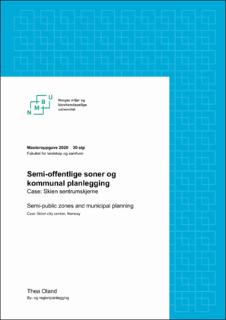| dc.contributor.advisor | Stefansdottir, Harpa | |
| dc.contributor.author | Oland, Thea | |
| dc.coverage.spatial | Norway, Telemark, Skien | en_US |
| dc.date.accessioned | 2020-10-06T16:16:44Z | |
| dc.date.available | 2020-10-06T16:16:44Z | |
| dc.date.issued | 2020 | |
| dc.identifier.uri | https://hdl.handle.net/11250/2681442 | |
| dc.description.abstract | Denne oppgaven handler om å skape attraktive og levende sentrumsområder ved å adressere semi-offentlige soner i den kommunale planleggingen. Semi-offentlige soner er eid og driftet av både private og offentlige aktører, og er et sentrale for hvordan vi oppfatter et sted. De nasjonale forventningene til regional og kommunal planlegging 2019-2023 sier at det i den kommunale planleggingen skal prioriteres å skape levende sentrumsområder, og går nærmere inn på fysisk utforming og aktivitet i bygningers første etasjer. Det kommer også frem i disse forventningene at det skal legges til rette for en økt innsats mellom kommunen, private aktører og innbyggere (Kommunal- og moderniseringsdepartementet 2019). Problemstillingen i denne oppgaven handler om hvilken rolle semi-offentlige soner har i å oppnå disse forventningene. For å finne ut av dette er det brukt en metodetriangulering, bestående av litteraturstudie, casestudie og kvalitative intervjuer. Casestudiet er avgrenset til Skien sentrumskjernene og består av et situasjonsbilde, gjennomgang av relevante offentlige dokumenter og observasjoner av semi-offentlige soner innenfor avgrensningen.
Informasjonen som er hentet inn belyser hvordan fysisk utforming og bruk av semi-offentlige soner er en viktig del av den attraktive og levende byen, og offentlig-privat samarbeid. Et målrettet fokus på semi-offentlige soner kan være et sterkt virkemiddel i å nå både gårdeieres-, virksomheters- og kommunale planleggeres mål om å skape et attraktivt og levende bysentrum. I oppgaven belyses bla. tre diskusjonstemaer som påvirker hvordan de involverte aktørene adresserer semi-offentlige soner. Et om plan- og bygningslovens (2008) ‘oppskrift’ på kommunal planlegging, og at fysisk utforming og bruk av semi-offentlige soner som resultat kun blir en obligatorisk oppgave uten særlig omtanke. Bruken av unyanserte begreper for elementer innenfor semi-offentlige sone, i litteraturen og i plan- og bygningsloven (2008), som åpner for skjønnsmessig avveielser. Denne bruken av begreper kan gjøre at den faktiske forståelsen av bruk og fysisk utforming av semi-offentlig sone viker fra de involverte aktørene. I intervjuene kommer det frem at for enkelte gårdeiere og virksomheter som bestemmer bruken og fysisk utformingen av semi-offentlige soner kjenner frustrasjon og følelser av maktesløshet i forhold til deres kreative utfoldelse i møte med kommunal planlegging. | en_US |
| dc.description.abstract | The topic of this thesis is about creating attractive and vibrant city centers, by addressing semi-public zones in municipal planning practice. Semi-public zones are owned and regulated by both private and public interests and are key to how we perceive a place. The Norwegian national expectations regarding regional and municipal planning 2019-2023 stipulate that in priority should be given to creating vibrant city centers. With additional focus on physical design and activity on ground floors. It is also stated in the expectations that there should be an increased effort in collaboration between the municipality, private interests and residents (Kommunal- og moderniseringsdepartementet 2019). In this thesis I approach the question of what role the semi-public zones have in achieving these expectations. To address the issue, I used a mixed method research consisting of a literature study, a case study and qualitative interviews. The case study is confined to the city center in Skien, Norway and consists of a situational picture, a review of relevant public documents and observations of semi-public zones within the case area.
The gathered information illustrates how physical design and use of semi-public zones is an important part of the attractive and vibrant city center, and public-private collaboration. A targeted focus on semi-public zones in municipal planning practice can play an important part in achieving the goals of both local landlords, businesses and municipal planners to create attractive and vibrant city centers. Through this study, three main discussion topics emerges. One, about the Norwegian Planning and Building Act’s (2008) guidelines for municipal planning, and that the physical design and use of semi-public zones as a result only becomes a mandatory task without special consideration. Second, about the use of imprecise expressions regarding elements within the semi-public zone. These expressions may cause the actual understanding of the use and physical design of semi-public zones to deviate from the interests involved. Third, in the interviews, it appears that for some local landlords and businesses that determine the use and physical design of semi-public zones feel frustration and feelings of powerlessness in relation to their creative expression in the face of municipal planning. | en_US |
| dc.language.iso | nob | en_US |
| dc.publisher | Norwegian University of Life Sciences, Ås | en_US |
| dc.rights | Navngivelse-Ikkekommersiell-DelPåSammeVilkår 4.0 Internasjonal | * |
| dc.rights.uri | http://creativecommons.org/licenses/by-nc-sa/4.0/deed.no | * |
| dc.subject | Urban planning | en_US |
| dc.subject | Byplanlegging | en_US |
| dc.title | Semi-offentlige soner og kommunal planlegging : case : Skien sentrumskjerne | en_US |
| dc.title.alternative | Semi-public zones and municipal planning : case : Skien city center, Norway | en_US |
| dc.type | Master thesis | en_US |
| dc.subject.nsi | VDP::Samfunnsvitenskap: 200 | en_US |
| dc.source.pagenumber | 84 | en_US |
| dc.description.localcode | M-BYREG | en_US |

